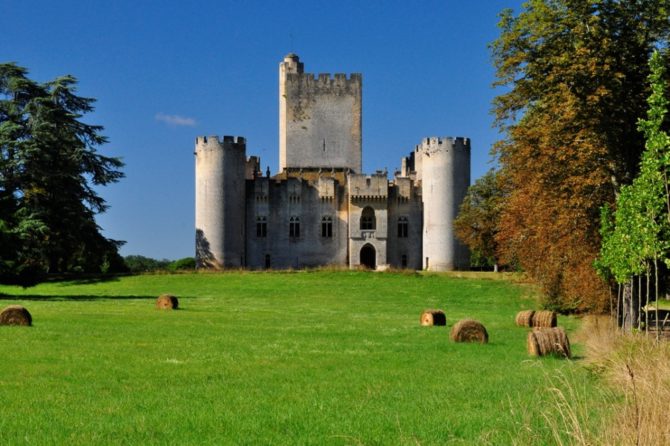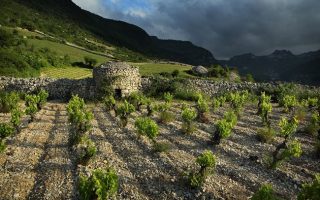Going for Graves

These days, the word Bordeaux conjures images of ultra-expensive wine that only those with deep pockets can enjoy. But the image is not entirely true. The lovely Graves region, for example, stretching some 30 miles south of Bordeaux along the western bank of the Garonne, offers high-quality wines that barely dent your finances.
Ask a connoisseur about Graves and you will surely hear the words “smoky” and “supple” to describe the reds. Made primarily from cabernet sauvignon, along with some merlot, the reds of Graves are typically more approachable than the cabernet sauvignon-driven wines from the northern Médoc, because temperatures in Graves tend to be a bit higher. Combine that with the region’s characteristic gravelly soils, which retain more heat than clay, and you get less tannic cabernet, with beguiling, tobacco-infused flavors.
But Graves is even more famous for Bordeaux’s very best dry white wines, made mostly from sauvignon blanc and sémillon. They are typically fresh and medium-bodied, not as brisk as Loire Valley Sancerre, but certainly thirst quenching. Top estates including Haut-Brion and Domaine de Chevalier craft whites that can compare with the finest of white Burgundies.
Popes and philsophers
While the Médoc is impressive with its stately châteaux—Lafite Rothschild, Mouton Rothschild, Margaux—the Graves region exudes charm, its gently rolling hills and forests imbued with wine culture and history.
Centuries before the Médoc marshes were cleared for viticulture, wine was made in Graves. Its most renowned estate, Château Haut-Brion, dates to the mid-16th century. So famed was Haut-Brion that it could not be excluded from the (nearly) exclusive Médoc wine classification of 1855, and made the list at the very top.
Other Graves estates predate Haut-Brion,and their beauty can be breathtaking. The 14th-century Château de Roquetaillade, which produces both red and white wines, is a national historic monument and a unique example of feudal architecture: two fortresses within the same massive stone walls. Another medieval castle nearby—although it’s not a wine producer—is the Château de La Brède, surrounded by a vast moat and an English garden park. It was the home of 18th-century philosopher and writer Charles-Louis de Secondat, Baron de La Brède et de Montesquieu. Pope Clément V, born near Bordeaux in 1264, inherited the vineyard property that later became Château Pape Clément, in Pessac. Oddly enough, the wines produced at the 13th-century château are today considered to be a more modern-styled and concentrated version of Graves.
New appellation
Over time, the vineyards of northern Graves became recognized for their higher quality, and by 1959, certain of their wines obtained cru classé status. All the classed growths now come from the northern sector, but it wasn’t until 1987 that the area won its own appellation, Pessac-Léognan, now counting about 4,000 acres and named after its two main towns. Taking price into account, my favorite Pessac-Léognan red is the Grand Cru Classé Château Haut-Bailly; my favorite white is the Grand Cru Classé Domaine de Chevalier.
But savvy buyers should note that southern Graves includes superb wines that are especially underpriced. Take the cooler vintage year 2008, which seemed to find its match in some of the warmer southern Graves soils, including truly excellent Château Magence and fine Château de Chantegrive in both red and white. Other undervalued wines from the southern Graves include Château Magneau, Château Grand Abord and Clos Floridène.
Scorching sun
When I arrived in Bordeaux late last September, the local newspaper proclaimed “a vintner’s vintage”. As the harvest was coming to an end, I could see rotted grapes left behind on the vines like so many battle casualties after choosy pickings, and unripe grapes within the bunches—the result of weather that began with a very dry spring. By mid-June, dry weather combined with warmth and occasional high heat led to talk about the “earliest harvest of the century” across all of France. But extreme temperatures in Graves in late June reached as high as 42°C, or 107.6º F, shocking vines already deprived of water.
“There are only two days to remember for 2011,” says Paulin Calvet of Château Picque Caillou, near Léognan, “June 26 and June 27”. The heat was such that some bunches had one side burned while the other side was alright, he explained. “We just barely averted a catastrophe.” Making things worse was the side effect of an organic liquid, terpène de pin, or pine terpene, whose purpose was to protect grapes from rot. Coated on grapes, the liquid acted like a magnifying glass when the sun bore down in late June, says vineyard manager Karin Dubois Reyes at Château Haut-Bergey in Léognan. But this excellent estate, like some others in Bordeaux, used an optical sorting machine that helped to eliminate unwelcome grapes.
The scorching heat of June was followed by uneven weather throughout the summer: July proved cold, August was almost normal, but there was rain in September. So 2011 is a vintage that challenged vintners; those who took the time to select grapes most carefully will make the better wines.
Wine writer Hugh Johnson wrote that beginners in Bordeaux often find their greatest pleasure with Saint-Emilion, whose merlot-based wines are the most accessible. If that is the case, then the Graves region is a link between the richer, more open merlots of Saint-Emilion and the more tannic cabernet sauvignons of the Médoc. Take note, however! As climate change pushes temperatures higher—and merlot reaches almost scary levels of alcohol—cabernet-governed Graves looks more and more appealing as the first place to go in Bordeaux.
Best recent vintages
Whites: 2010, 2008, 2007, 2006, 2002, 2001.
Reds: 2010, 2009, 2005, 2004, 2001, 2000.
Panos Kakaviatos writes regularly on wine. www.connectionstowine.com
Originally published in the February 2012 issue of France Today
Share to: Facebook Twitter LinkedIn Email
Leave a reply
Your email address will not be published. Required fields are marked *




REPLY